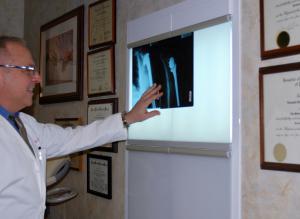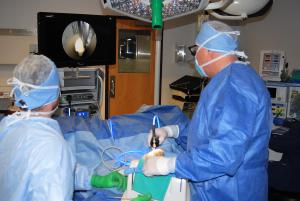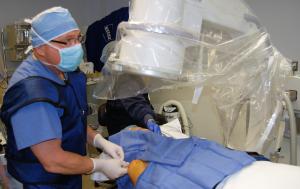Orthopedic surgeon Dr. Leonard Marchinski publishes explanatory article on Upper Extremity Orthopedics – Wrist Surgery
The new article by Dr. Leonard Marchinski discusses different types of wrist surgeries and why they are performed.
LEONARD JOSEPH MARCHINSKI, M.D. (N/A:N/A)
Carpal tunnel release involves increasing the space for the pressed nerve, thereby reducing pressure on it, by dividing the roof of the carpal tunnel.”
WYOMISSING, PENNSYLVANIA, UNITED STATES, May 16, 2019 /EINPresswire.com/ -- The only chances that you know what the term “upper extremity” means is if you or a loved one has ever been recommended by a General Practitioner (GP) to visit an upper extremity specialist, or you came across the term online and then searched to know what it means.— Dr. Leonard J. Marchinski, Pennsylvania, orthopedic surgery
Dr. Leonard J. Marchinski explains this subject in a new article. The complete article will be available on Dr. Marchinski’s blog at https://leonardmarchinskimd.wordpress.com/
What is the Upper Extremity?
Upper extremity is a medical term for the upper limb. It is an umbrella term for the bones, muscles, joints, blood vessels, nerves, tendons, ligaments, and soft tissues present in the shoulder, arm, forearm, wrist, and hand.
What is Upper Extremity Orthopedics?
Most any bone, tendon, or ligament repair or reconstructive procedure or surgery that is performed to treat a problem in the upper extremity area falls under the category of upper extremity orthopedics.
Causes of Problems in the Upper Extremity Region
Since our arms are the most widely used part of the human body, they are also exposed to many risk factors that can affect their functioning by damaging one or multiple areas of the upper extremity. Ligament tears, fractures, and tendon or nerve damage are some common issues that can cause pain or loss of function of one part of the upper extremity area or the whole upper limb.
Problems in this region can be the result of accidents or certain health conditions, like:
* Arthritis
* Infections
* Tumors
* Carpal tunnel/Nerve compression syndromes
* Tendonitis
* Trigger finger
* Traumatic and degenerative conditions of bones, ligaments, tendons and muscles
Types of Wrist Surgeries
Here are some types of wrist surgeries that are widely performed:
1. Fracture Repair
While surgery is not usually required in most fracture cases, it becomes necessary in certain conditions, such as:
* When the bones are out of position
* When the bones are unstable or fragmented
* If the fracture has affected a joint
The type of surgery performed depends on the type, severity, and the location of the fracture. However, in most cases, it involves placing the bones in the correct position and securing them with a small plate and screws. In some cases, pins may be used to hold the bones in their place.
2. Carpal Tunnel Release
A type of upper extremity surgery that is performed to treat carpal tunnel syndrome is called carpal tunnel release.
Carpal tunnel syndrome is a common health condition caused by when the median nerve – a nerve that controls movements and feelings in the hand – gets pressed in the wrist area due to the narrowing of the carpal tunnel.
Carpal tunnel is a narrow passageway, made of bones and ligaments, through which the median nerve enters the hand. It is located at the base of the hand on palm side of the wrist. The tunnel usually gets swelled and, as a result, narrowed due to repetitive hand and wrist movements, such as typing with hands lower than the wrists. However, the condition can also be the result of some health conditions, like arthritis, diabetes, trauma, obesity, and hypothyroidism.
Carpal tunnel syndrome causes numbness, tingling sensation, and pain in the affected wrist and hand. It also makes the person experience weakness of hand and loss of coordination and grip strength, if not treated immediately. In worst case scenario, the patient can completely lose the functioning of hand.
Carpal tunnel release involves increasing the space for the pressed nerve, thereby, reducing pressure on it, by dividing the roof of the carpal tunnel. While the most common way to perform this surgery is through the open technique, the surgeon may opt for endoscopy instead.
Carpal tunnel release is a small procedure that usually takes around 5 to 10 minutes and is performed by giving local anesthesia to the usually sedated patient.
3. Wrist Tendonitis Surgery
As evident from the name, this type of surgery is performed to treat wrist tendonitis – one of the most common causes of wrist pain. The condition is caused by the thickening of the tendons and surrounding sheaths, which causes irritation and inflammation of the tendons in the wrist joint and makes wrist movements painful. The condition can be caused due to an injury or repetitive motions.
Surgery is not often the first choice for treating wrist tendonitis and is only opted when medicines or other treatments fail to provide any relief. The procedure involves loosening the thickened or narrowed sheath area that has been limiting the movement of tendon(s) or making it painful. In order to create the space, the doctor may remove the inflamed tissues in the affected area.
These are only a few types of the wrist surgeries performed worldwide to treat fractures or damages in the particular area of the upper extremity. Many other surgeries have also emerged thanks to the advancements in the fields of surgery and medical science.
About Leonard Joseph Marchinski, MD
Dr. Leonard J Marchinski is a medical doctor in Pennsylvania, focusing on orthopedic surgery. In addition to General Orthopedics, Dr. Marchinski provides medical and surgical treatments such as:
* Endoscopic Carpal Tunnel Release and treatment of similar Nerve Compression Syndromes
* Wrist Arthroscopy and treatment of Wrist Instability
* Reconstruction of the Base of the Thumb Joint
* Tendon and Ligament Repair, Reconstruction, Transfers
* Shoulder Replacement
* Operative and Non-Operative Fracture Care
Dr. Leonard J. Marchinski received his undergraduate education at St. Joseph’s University in Philadelphia (Biology, 1974-1977), and his Medical Degree in 1981 from The Medical College of Pennsylvania (now Drexel-Hahnemann).
References
Website: https://leonardmarchinskimd.com/
Video: https://video.vitals.com/Dr_Leonard_Marchinski.mp4
Blog: https://leonardmarchinskimd.wordpress.com/
News: https://medicogazette.com/dr-leonard-j-marchinski#79296231-68fa-4702-9a29-11f9238139ea
News: https://hippocratesguild.com/dr-leonard-j-marchinski
News: https://hype.news/leonardmarchinskimd/
Reference: https://health.usnews.com/doctors/leonard-marchinski-253046
LinkedIn: https://www.linkedin.com/in/dr-leonard-marchinski-174236181/
Dr. Leonard J. Marchinski
LEONARD JOSEPH MARCHINSKI, M.D.
+1 484-709-1515
email us here
Visit us on social media:
LinkedIn
Mayo Clinic Minute: Symptoms, solutions for carpal tunnel syndrome





